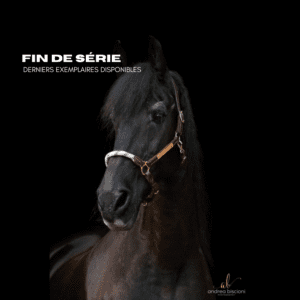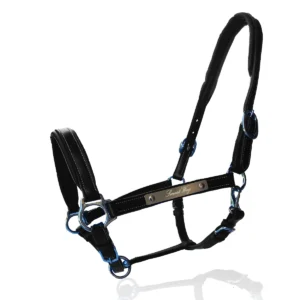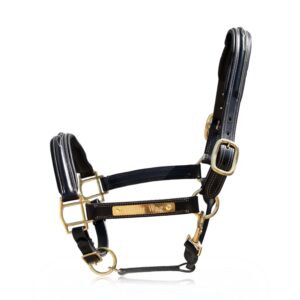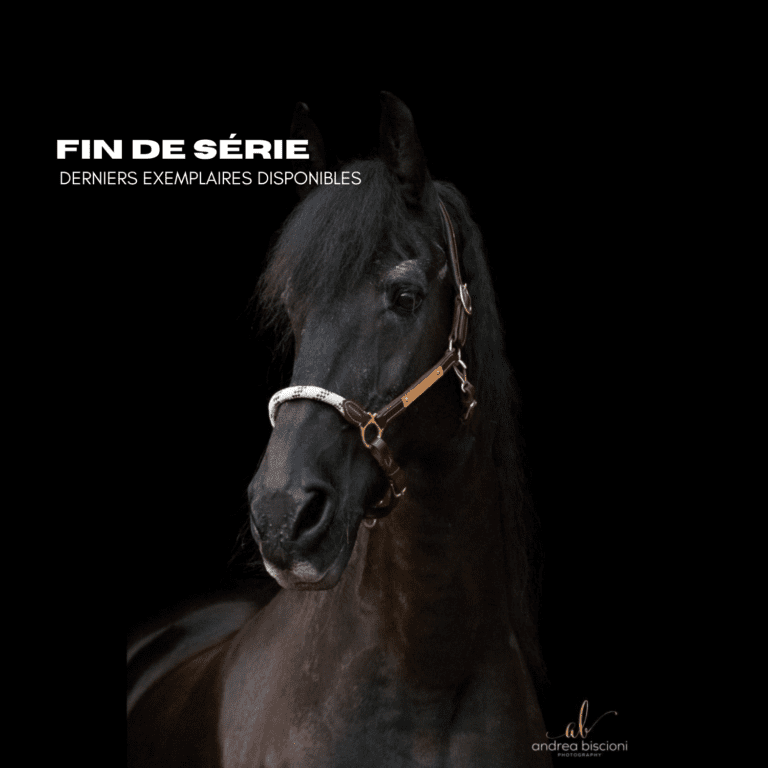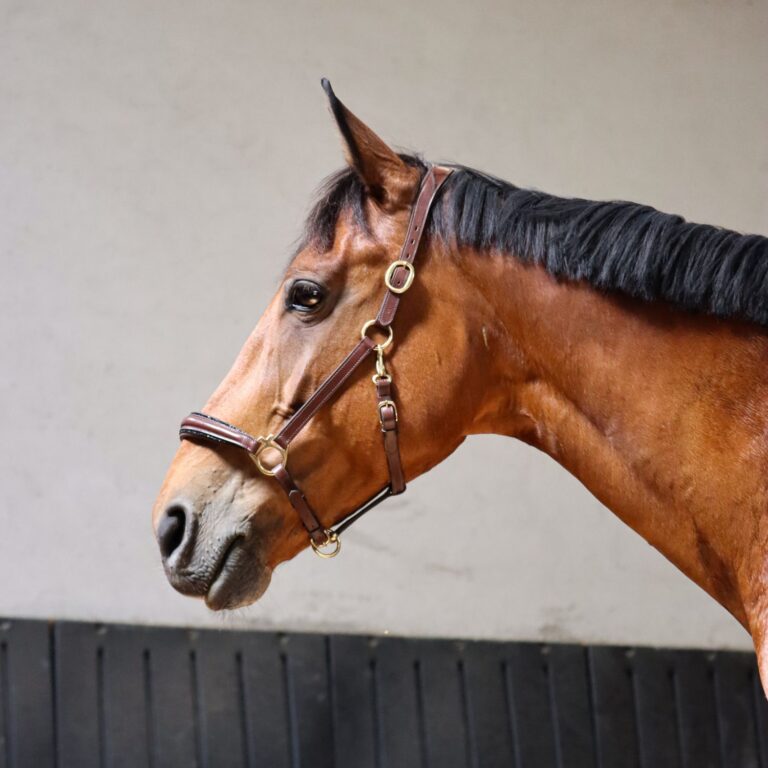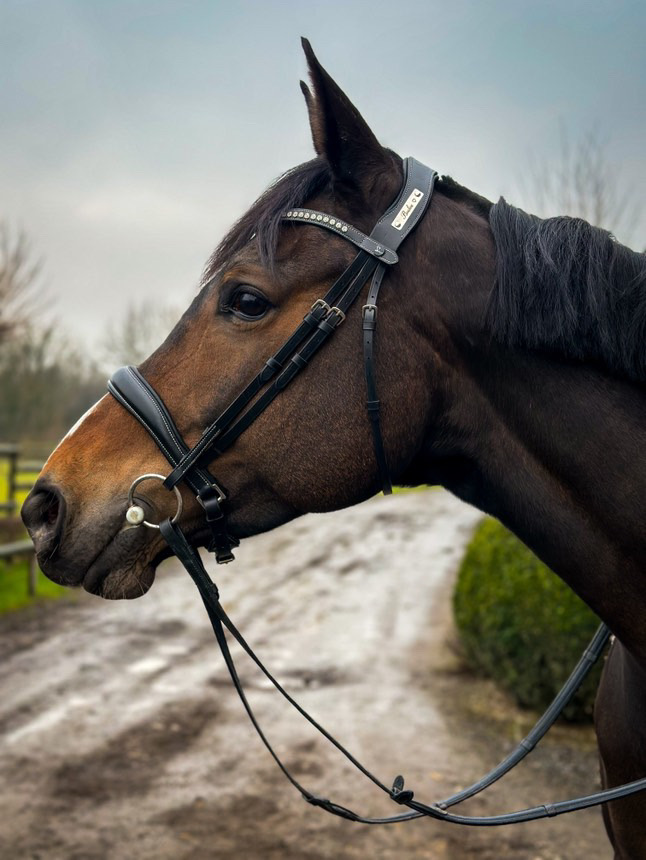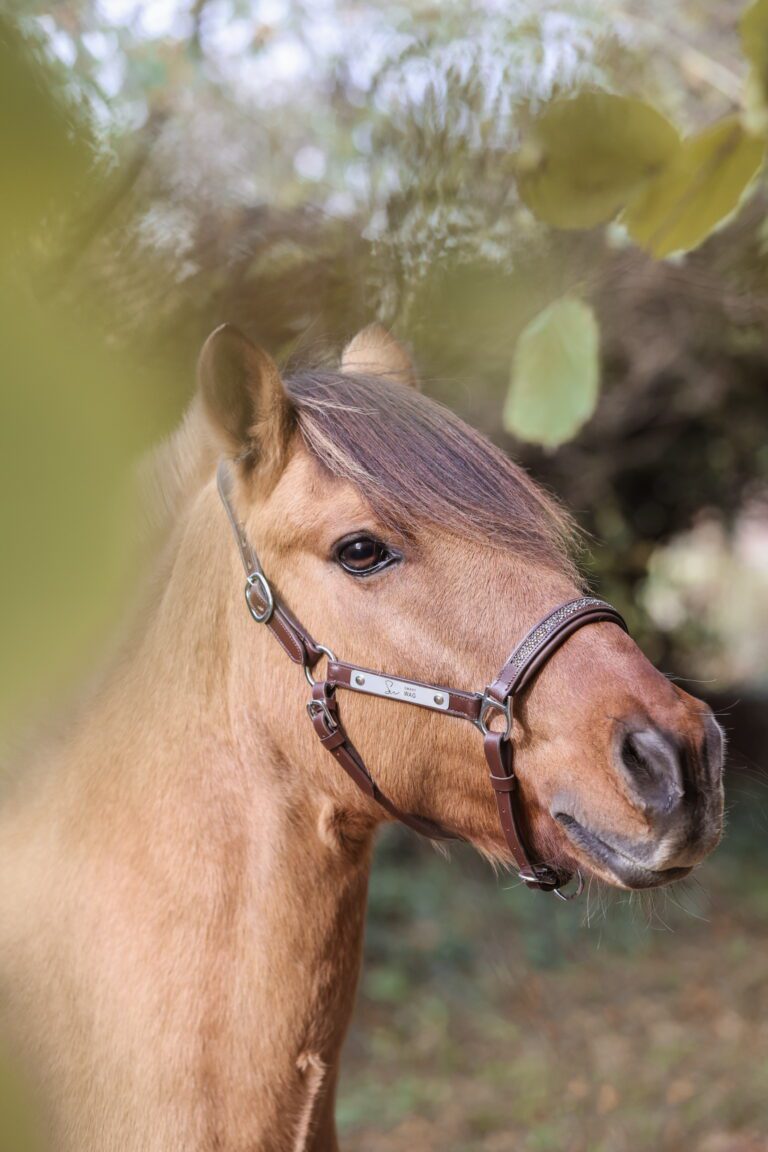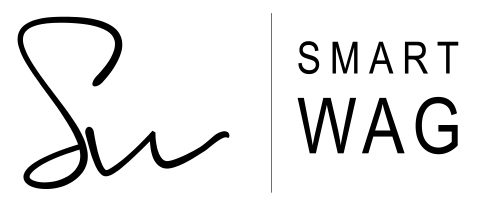Table of halter sizes and measurements
| Size | Noseband (A) | Headrest (B) | Amount (C) | ||
|---|---|---|---|---|---|
| Min | Max | Min | Max | ||
| MINI / POULAIN | 38 | 44 | 36 | 42 | 9 |
| SHET | 46 | 50 | 44 | 58 | 12 |
| PONEY | 50 | 60 | 48 | 62 | 16 |
| DOUBLE PONY / COB | 58 | 68 | 52 | 66 | 19 |
| FULL | 60 | 70 | 56 | 70 | 21 |
Choose a suitable halter is crucial to your horse's comfort and safety. A poor fit can cause injury and interfere with communication with your horse. This guide will help you make the right choice, whether you're a beginner or an experienced user.
How do I use this table to choose a halter?

Measure your horse's head
Take a tape measure and measure :
- Autour du nez (muserolle).
- Sur le dessus de la tête (têtière), de la base d’une oreille à l’autre.
- Les montants, de la place de la muserolle ( à 2 doigts des apophyses zygomatiques ) jusqu’à la têtière.

Compare with the size ranges in the table
Identify in which range your measurements fall for each part.
Example If your horse has a nose circumference of 57 cm, a headpiece of 64 cm and uprights of 20 cm, it corresponds to size COB.

Adapt to overlaps
If your horse's measurements are on the borderline between two sizes (for example, a 60 cm noseband that is in both PONEY max and COB min), choose the larger size to ensure greater comfort and adjustability.
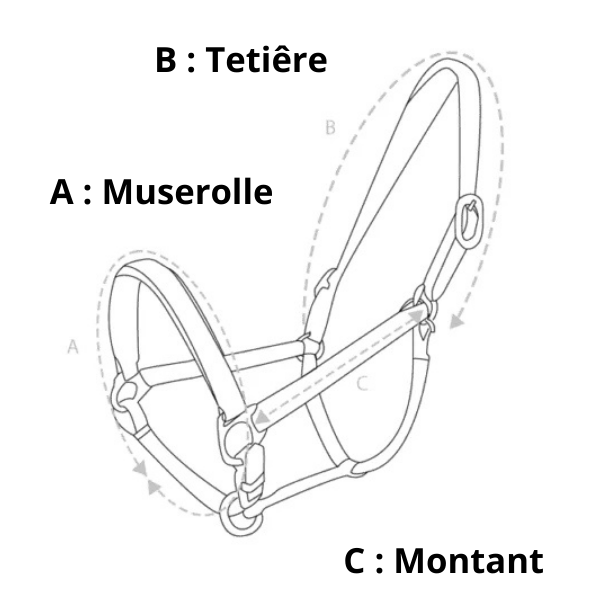
Understanding the different parts of the halter
A well-designed halter consists of three main parts which must fit perfectly to ensure comfort and safety:
- The noseband (A): goes around the horse's nose and plays a crucial role in control.
- The headband (B): fits behind the ears and holds the whole assembly in place
- Uprights (C): connect the noseband to the headpiece and ensure the stability of the halter.
Tips for an optimum fit
A properly fitted halter must meet several essential criteria:
- The noseband should be placed about 2 fingers wide of the horse's zygomatic process to avoid rubbing the nerves of the face.
- It must be possible to pass a hand through between the horse's trough and the noseband.
- The headrest must not exert any excessive pressure on the ears and must allow them full mobility.
- The amounts must keep the whole in balance.
What are the signs of a poor fit?
Knowing how to recognise the signs of an ill-fitting halter is crucial:
- Friction marks on the skin;
- Incorrect noseband position (too high or too low) ;
- Difficulty breathing or chewing ;
- Excessive tension in the ears;
- Imbalance in overall maintenance ;
- Halter that goes over the ears.
Smart Wag: halters for horses of all sizes
Size
Suggested halter
-
Halter and Leadrope
Leather and Rope customizable halter
59.00 € Select Options Ce produit a plusieurs variations. Les options peuvent être choisies sur la page du produit
Size
Suggested halter
-
Halter and Leadrope
Soul customizable halter
59.00 € Select Options Ce produit a plusieurs variations. Les options peuvent être choisies sur la page du produit
Size
Suggested halter
-
Horse equipment
Customisable leather halter Flags
65.00 € Select Options Ce produit a plusieurs variations. Les options peuvent être choisies sur la page du produit
Size
Suggested halter
-
Halter and Leadrope
Exclusif customizable halter
69.00 € Select Options Ce produit a plusieurs variations. Les options peuvent être choisies sur la page du produit
Size
Suggested halter
-
Halter and Leadrope
Soul customizable halter
59.00 € Select Options Ce produit a plusieurs variations. Les options peuvent être choisies sur la page du produit
The different types of materials for your halter
| Material | Benefits | Disadvantages |
|---|---|---|
| Leather |
|
|
| Nylon |
|
|
| Rope (Ethological) |
|
|
| BioThane® |
|
|
Go further in choosing your halter
SHET size (Shetland)
- Noseband: 46-50 cm
- Head rest: 44-58 cm
- Uprights: 12 cm
Ideal for Shetland ponies and very small ponies, this size is specifically designed for small equines. It takes into account their particular proportions and guarantees a fit adapted to their unique morphology.
Pony size
- Muzzle: 50-60 cm
- Headrest: 48-62 cm
- Uprights: 16 cm
Suitable for medium-sized ponies (sometimes called double ponies). It is particularly well suited to breeds such as New Forest or Welsh B, while adapting to different head morphologies.
Cob size
- Noseband: 58-68 cm
- Head rest: 52-66 cm
- Uprights: 19 cm
Suitable for large ponies and medium-sized horses with thin heads, the Cob size is an excellent compromise. It is particularly suitable for breeds such as Quarter Horses, Haflingers and Camargue horses, offering stability and comfort.
Full size
- Muzzle: 60-70 cm
- Head rest: 56-70 cm
- Uprights: 21 cm
Suitable for large horses such as Selle Français or other sport horses with large, long heads. These dimensions ensure a comfortable fit while maintaining effective communication for greater control.
Specific recommendations depending on the activity
The type of halter you choose also depends on the activity you plan to do with your horse. Here are some specific recommendations:
- Transport Opt for a leather halter, which is often considered safer because it can break in an emergency, reducing the risk of injury.
- Competition Choose a leather halter with a top-of-the-range finish, combining comfort and elegance for an impeccable appearance.
- Work in hand Opt for a flat halter for basic training work. A halter with rope details can be used for more finesse.
What is an ethological halter?
The ethological halter (A rope halter is a light, flexible halter used in horse riding for both mounted and dismounted work, providing a different approach to communicating with the horse. Unlike conventional nylon or leather halters, they are made from fine rope, often polyester or polypropylene, and have no metal buckles or snap hooks.
Its design is based on strategically placed knots to maintain correct structure. Thinner than a conventional flat halter, it exerts more targeted pressure on the horse's head when tension is applied to the lead rope. This allows for more subtle and responsive communication, which is often emphasised when working with a horse. ethological/behavioural equitation.
It is often used to educating young (and not so young) horsesIt can be used for ground work and mounted work. However, it should not be used to tie up a horse, as its thinness could injure it if it is pulled too hard or if it falls.



